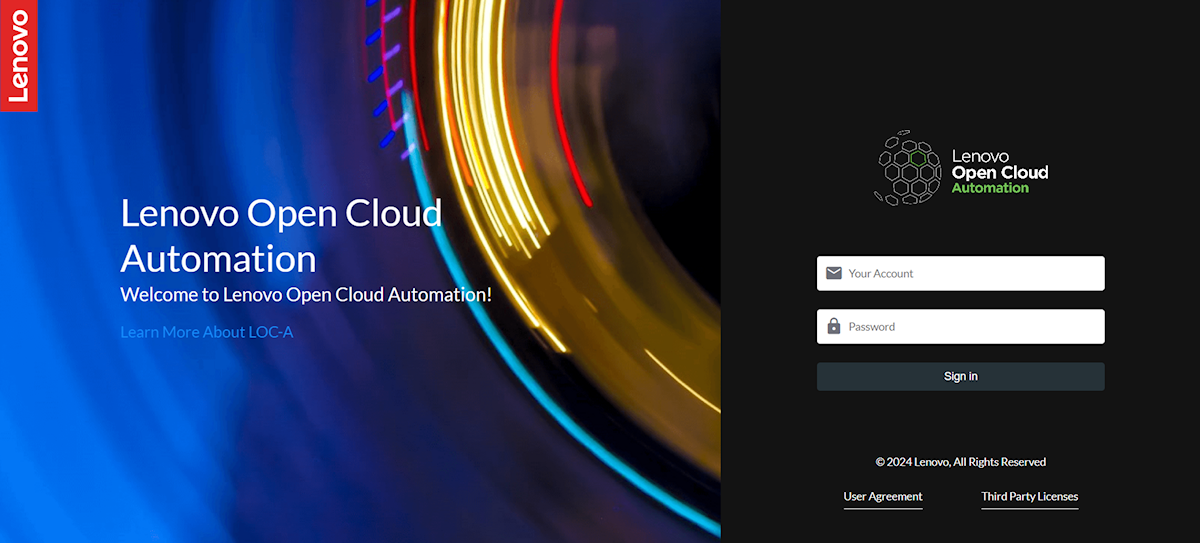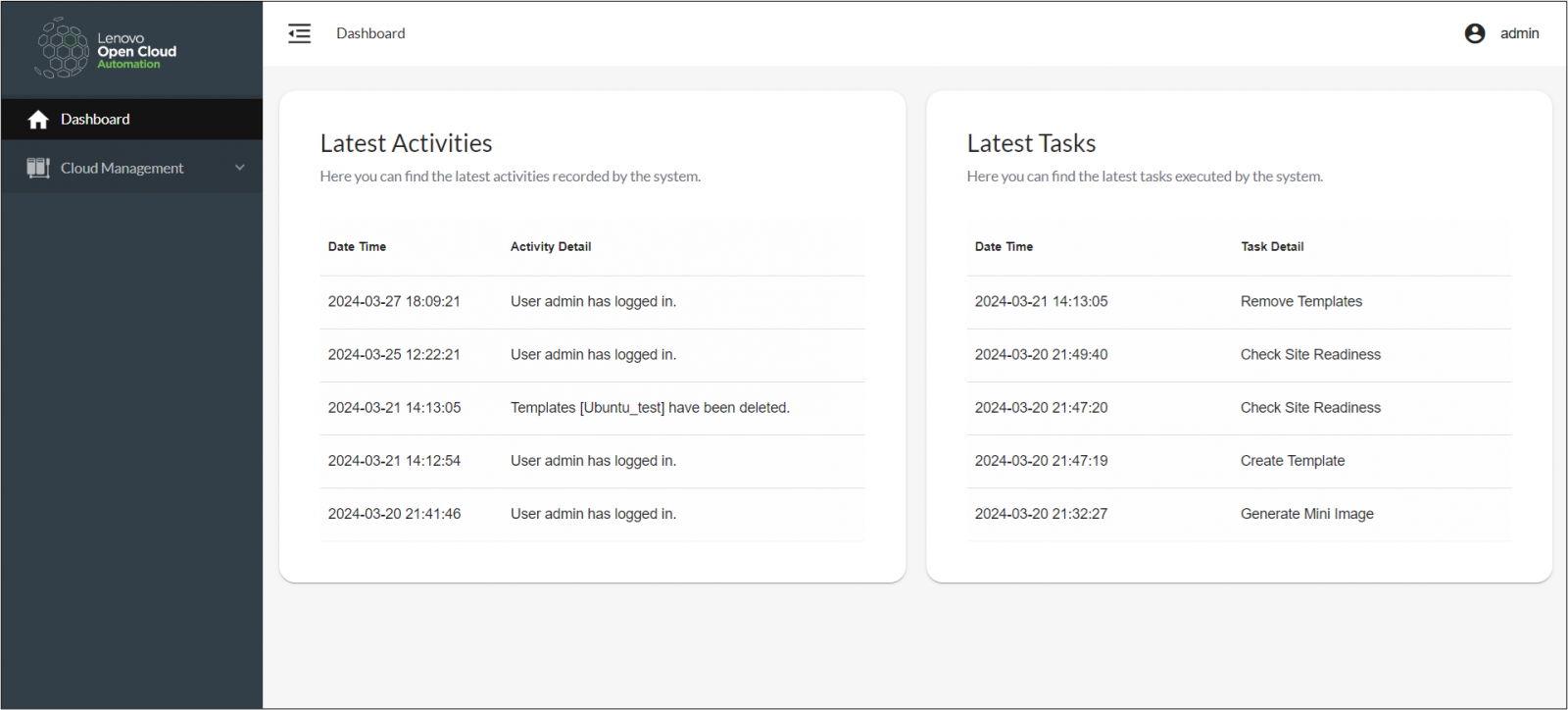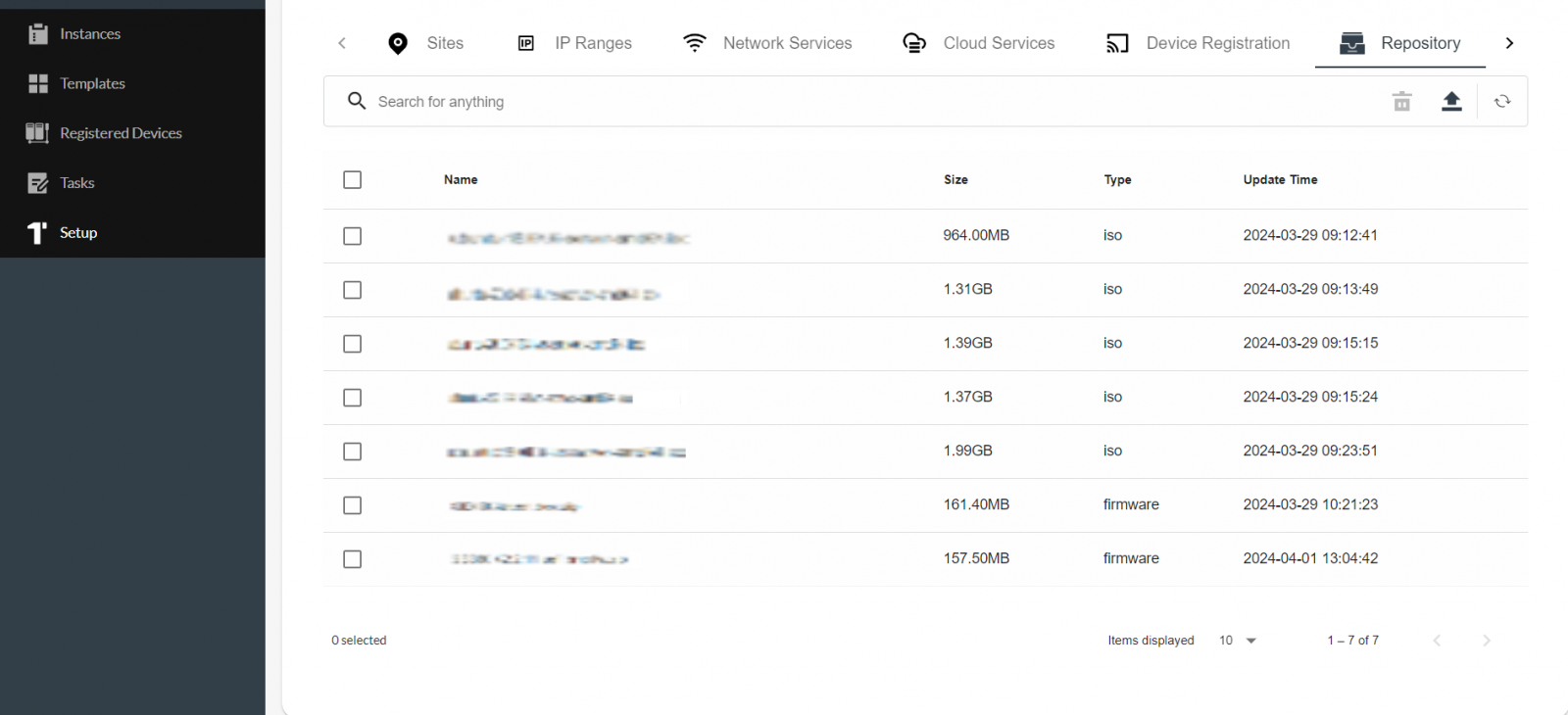Author
Updated
24 Apr 2025Form Number
LP1974PDF size
31 pages, 5.8 MBAbstract
Lenovo Open Cloud Automation (LOC-A) is a software solution that helps to securely accelerate the deployment of IT infrastructure, at scale. With LOC-A, IT infrastructure is deployed faster, with fewer resources required while also reducing the overall CO2 emissions of the process.
This product guide provides essential information to understand the key features and components of the Lenovo Open Cloud Automation offering. The product guide is intended for technical specialists, sales specialists, sales engineers, IT architects, and other IT professionals who want to learn more about LOC-A.
Change History
Changes in the April 24, 2025 update:
- Updated for LOC-A 3.4 – see the What’s new in LOC-A 3.4 section
- New feature added: Meta-data editing directly in the portal – see the Deployment planning section
- New feature added: Server registration and provisioning in datacenter by discovery for ThinkAgile MX Premier - see the Partner integrations section
- New feature added: Add support for multiple bootstrap versions - see the Partner integrations section
- New feature added: Add support for Cloud-Init - Cluster Template creation section
- Feature update: New version supported for Ubuntu – 24.04 - Cluster Template creation section
- New HW platforms supported: ThinkSystem SR650 V2, SR650 V3, SR630 V2, SR630 V3 - Supported ThinkSystem servers section
- Feature update: Improved Northbound API – see Integration section
Introduction
Lenovo Open Cloud Automation is a software solution that helps to securely accelerate the deployment of IT infrastructure, at scale. The main users that it serves are the deployment architect, the field technician, and the deployment project manager. With Lenovo Open Cloud Automation, IT infrastructure is deployed faster, with fewer resources required while also reducing the overall CO2 emissions of the process.
Lenovo Open Cloud Automation achieves this by embodying a simplified deployment process and by automating the steps of the process too complex for humans to execute without mistake. This delivers a standardized experience for both the and the field technicians, while still being customer, deployment, and site specific.
Did You Know?
LOC-A enables a single deployment architect to handle many installs simultaneously, all from the same deployment template. Running multiple installs saves time, driving more user productivity and delivering value faster for the business.
Lenovo Open Cloud Automation targets small (10 devices), medium (100 devices) to large (>10000 devices) IT deployments in diverse environments such as data centers, staging environments and Edge-specific environments for Retail, Telco, Oil & Gas, Healthcare, and others.
It uses a no-code, UI driven workflow to orchestrate metadata handling, edge node onboarding, OS deployment and cluster creation. LOC-A utilizes an encrypted network connection to securely onboard devices and communicate with the BMC, and it implements the concepts of Templates and Instances to enable scalable cluster bring-up.
What’s new in LOC-A 3.4
Lenovo recently announced LOC-A version 3.3, improving the overall functionality, including:
- ThinkAgile MX Premier: Server registration and provisioning in datacenter by discovery - Partner integrations section
- ThinkAgile MX Premier: Add support for multiple bootstrap versions - Partner integrations section
- Meta-data editing directly in the portal - Deployment planning section
- OS deployment: Add support for Cloud-Init - Cluster Template creation section
- OS deployment: update the version of Ubuntu OS to 24.04 - LTS - Cluster Template creation section
- HW platforms: Add support for OS deployment on SR630 V2 and SR630 V3, SR650 V2 and SR650 V3 - Supported ThinkSystem servers section
- Integrations: Simplified Northbound API
Ordering information
The following tables list the ordering information for LOC-A.
The following figure visually explains how the LOC-A licenses are packaged and what functionality is available for each type of category of part numbers. As shown in the figure, customers have the flexibility to chose the type of license that matches their scale and needs.
Features for users
Those designated as LOC-A users have access to portal pages related primarily to IT infrastructure deployment and maintenance tasks. Users can upload metadata, on-board devices, create deployment templates and policies and deploy, and monitor their results through the portal pages.
The following features are available to users:
- Dashboard
- Deployment planning
- Deployments
- Image Repository population
- Device profiles configuration
- Credential policies configuration
- Cluster Template creation – with flexible naming convention
- nZTP Registration image generation
- Device on-boarding using nZTP
- Device on-boarding using XCC IP
- Device on-boarding using XLSX file
- Device on-boarding using SLP-based discovery
- Device on-boarding using Layer 3 discovery
- Cluster and OS instance lifecycle management (creation, expansion, deletion)
- Automatic instance creation
Dashboard
The dashboard provides an overview of the latest activities that happened in the system. The latest tasks are also listed, indicating the start time and the order of tasks executed. The figure below displays the home menu.
Deployment planning
Deployment planning is a step that the Infrastructure Admin Team is responsible for. LOC-A expects that the output of the planning activity is filled into an excel file with a specific template that the Deployment Engineer can download from the LOC-A portal. Once that file is filled with the correct data about the deployment, the Infrastructure Admin Team can proceed with uploading the file into the LOC-A portal.
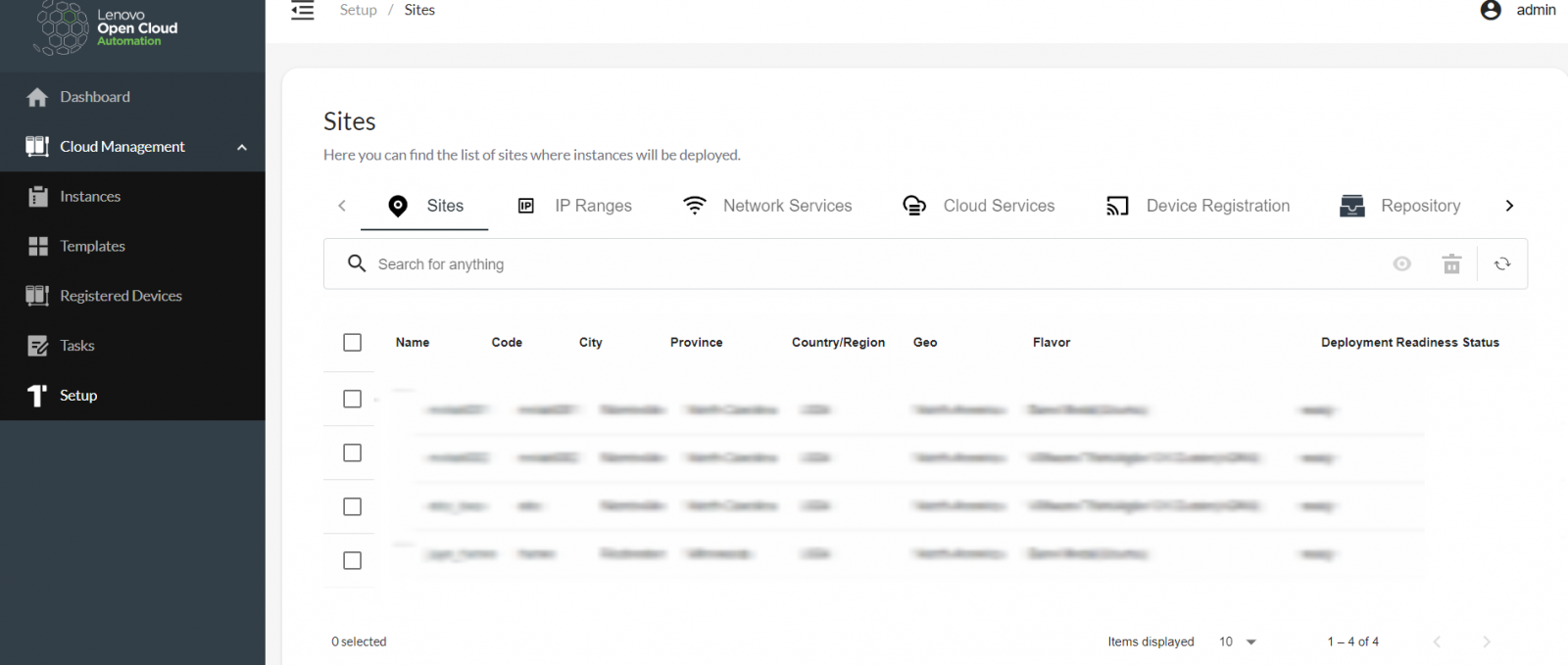
Figure 4. Metadata onboarded in the Setup page
Starting with release 3.3, users can add new metadata using the LOC-A Portal directly, without using the Excel template. This way, as the customer IT estate grows, more locations and their associated metadata can be added as they are ready for production usage. Additional metadata that can be added using a similar method included: IP Ranges, Network Services and Cloud Services. The following image depicts how a user can add a new site.

Figure 5. Creating a new site definition from the portal. Similar forms can be used to create IP Ranges, Network Services and Cloud Services
Starting with release 3.4, users can also edit/update the already defined meta-data, from the UI. This helps to easily correct mistakes without having to re-upload the meta-date Excel file. The following image depicts how a user can edit an existing site.

Figure 6. Editing an existing site definition from the portal. Similar forms can be used to edit IP Ranges, Network Services and Cloud Services
Deployments
Deployments are a new concept introduced in 3.3 that enables additional features for users. A deployment can have associations with multiple sites and multiple templates, each template with distinct flavor. One site can be associated to only one deployment, and 1 deployment cannot have association with multiple templates for the same flavor. The first feature that is added for deployments is called. For more information, please follow the link “Automated Instance creation”.
Image Repository population
Each Flavor used by a Cluster Template requires at least 1 OS image or artifact (for firmware update). Instead of including the OS image in the Cluster Template, we give users the flexibility to upload their own OS image for a particular flavor. To do that, LOC-A offers a repository in the Setup section. Below is an example of how that repository looks like:
Device profiles configuration
In LOC-A, every Cluster flavor can be mapped to a specific BMC configuration profile to meet the requirements of such flavors. Some of the settings that are needed by such flavors are: XCC: “Power Restore Policy”, UEFI: “Secure Boot”, etc. Device profiles are configured centrally and automatically applied when a device is on-boarded, before the cluster is installed.
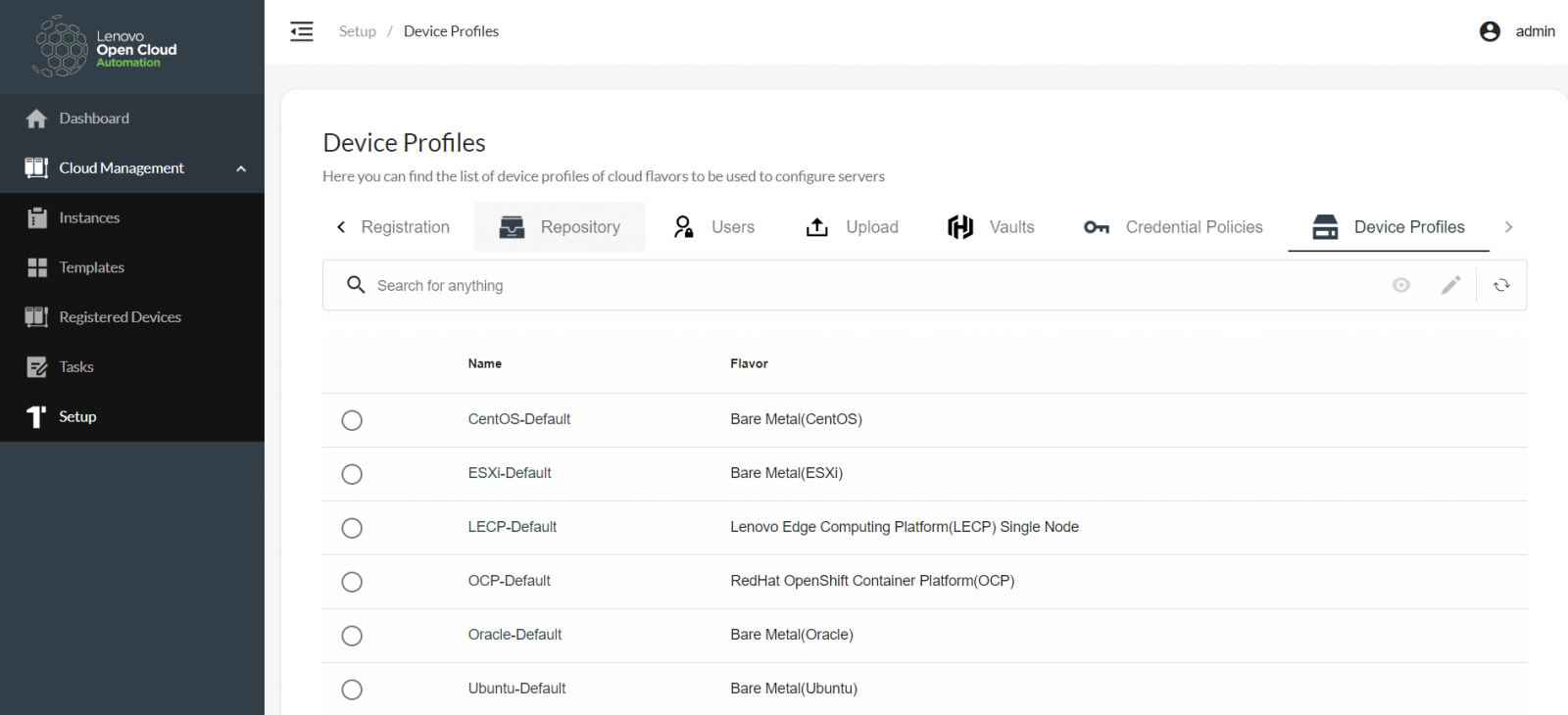
Figure 8. Device Profile selection and configuration
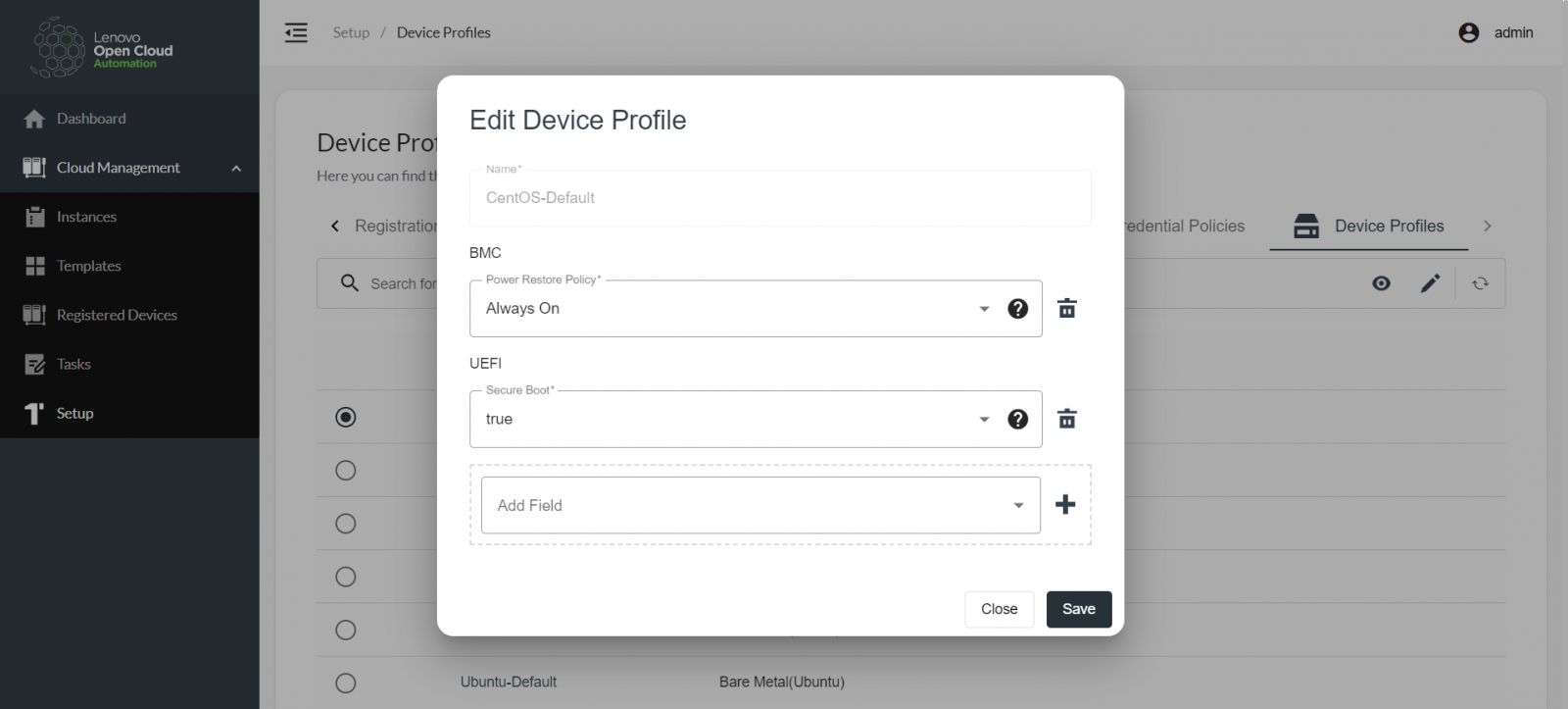
Figure 9. Device Profile editing
Credential policies configuration
LOC-A uses and sets three types of server credentials: BMC, UEFI, and OS. To improve the security posture and allow only the Infrastructure Admin Team to control how credentials are set, Lenovo Open Cloud Automation implements a few rules applicable to how credentials are generated and used throughout the server pool.
These policies are of 2 types: “static” or “auto generated”:
- Static: This type gives the option to set the same Infrastructure Admin Team created credentials for all servers deployed with the same Cluster template, for consistency purposes and easy management.
- Auto generated: This type gives the option to generate a new set of credentials for every device and for every type of login (OS, BMC, UEFI). The goal here is to remove the burden of having to generate and memorize unique passwords for every server and login combination, while at the same time not exposing the infrastructure to potential password discovery and re-use attacks.
Other types of credentials are also supported as part of the cluster flavor and cluster template definition (e.g.: pull secrets, certificates, etc.).
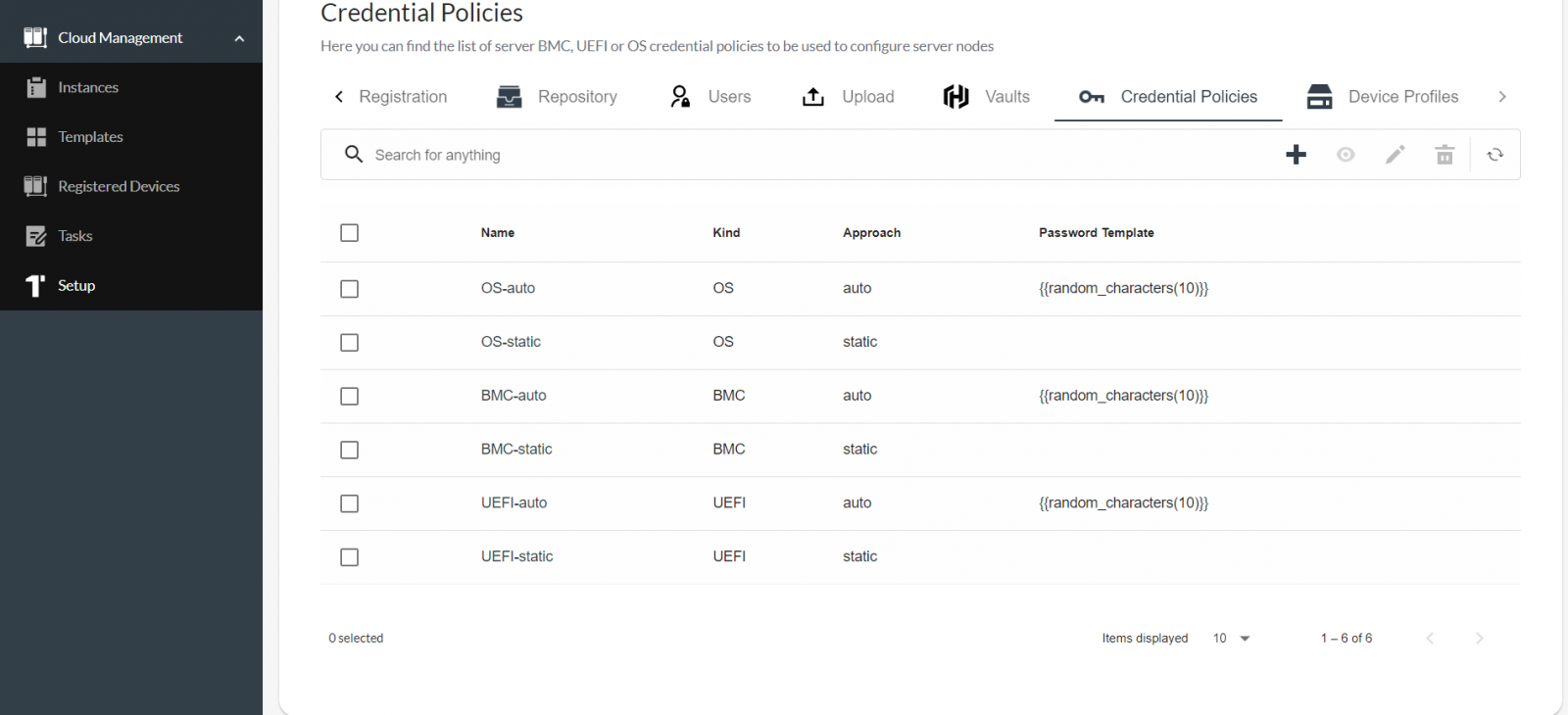
Figure 10. Credential Policies list
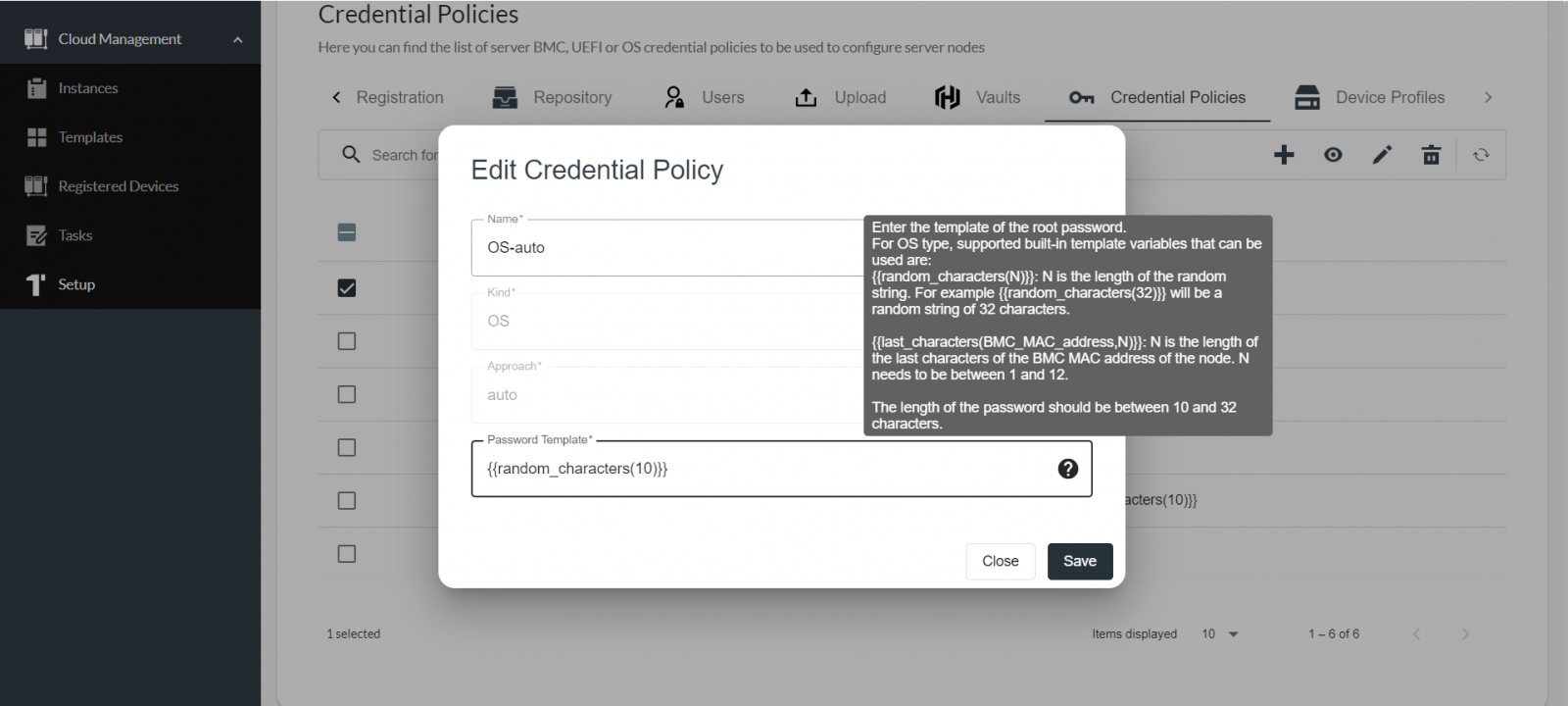
Figure 11. Credential Policy Editing – with rules
Cluster Template creation – with flexible naming convention
One of the most used concepts from the Lenovo Open Cloud Automation portal is the infrastructure definition Template. Once metadata is loaded and servers are on-boarded, the Infrastructure Admin Team uses the infrastructure Template to create instances of clusters or bare-metal nodes, in parallel and at scale. To do that, the Infrastructure Admin Team must first create one or more infrastructure Templates. Starting with LOC-A version 3.3, specifically for Ubuntu flavors, users can enable Full Disk Encryption for at-rest data security. To find out more, check the User Guide.
A sample Template for an ESXi bare-metal deployment is displayed in the figure below.

Figure 12. Bare-metal ESXi definition Template
From the 3.4 onwards, the Ubuntu flavor is enhanced with the capability of using cloud-init for setting up the OS during the boot process, complementing the post-script capability.
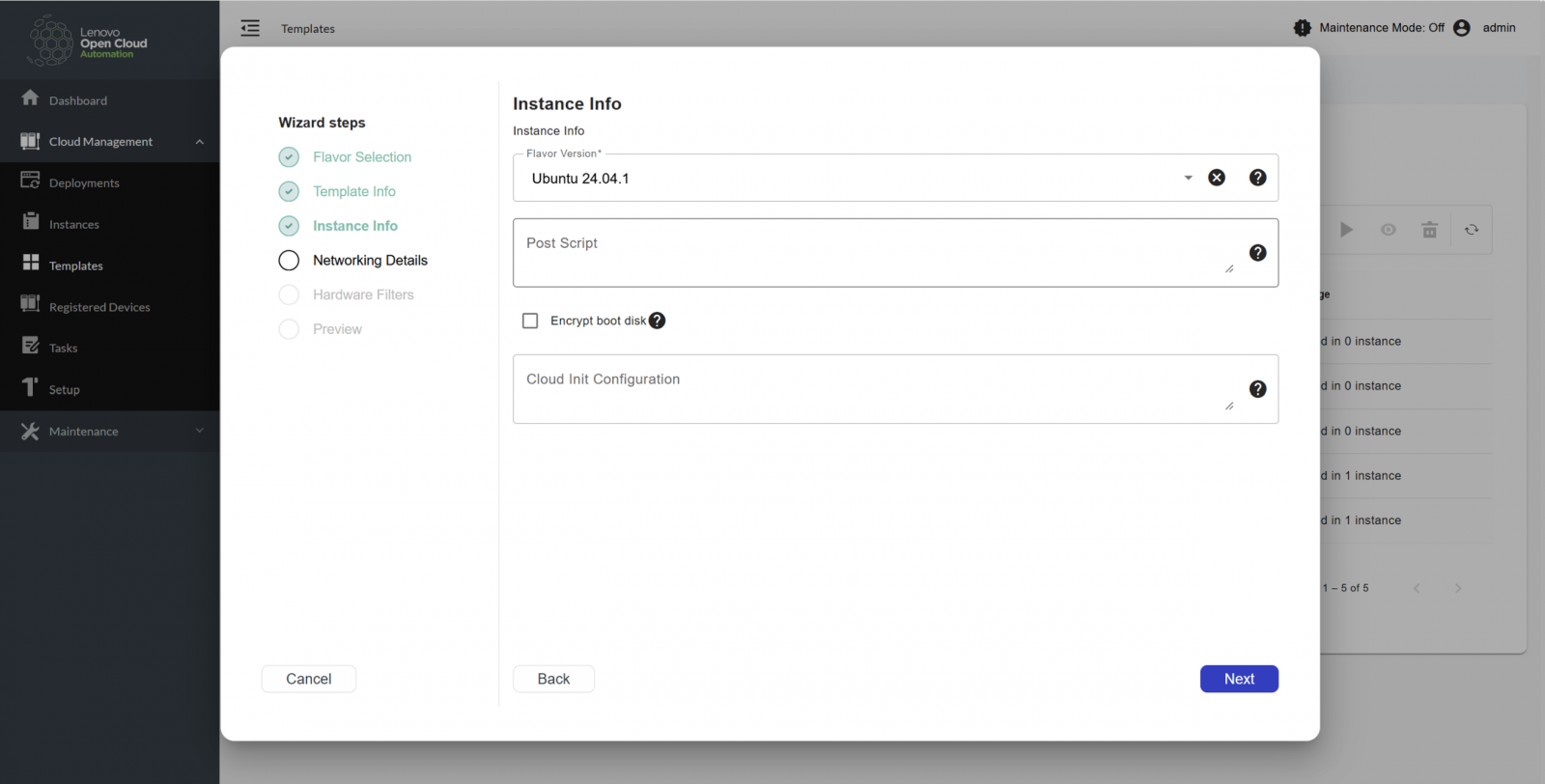
Figure 13. Ubuntu Bare-metal Template with: Cloud init, boot disk encryption and latest version of Ubuntu
nZTP Registration image generation
To enable near-Zero Touch Provisioning of servers at the edge, after uploading the metadata describing the deployment, the Infrastructure Admin Team generates one or more Registration Images that allows the Field Technicians to perform the registration process using their Laptop and the Lenovo Open Cloud Automation Registration Utility. In the figure below you can see a generated registration image.
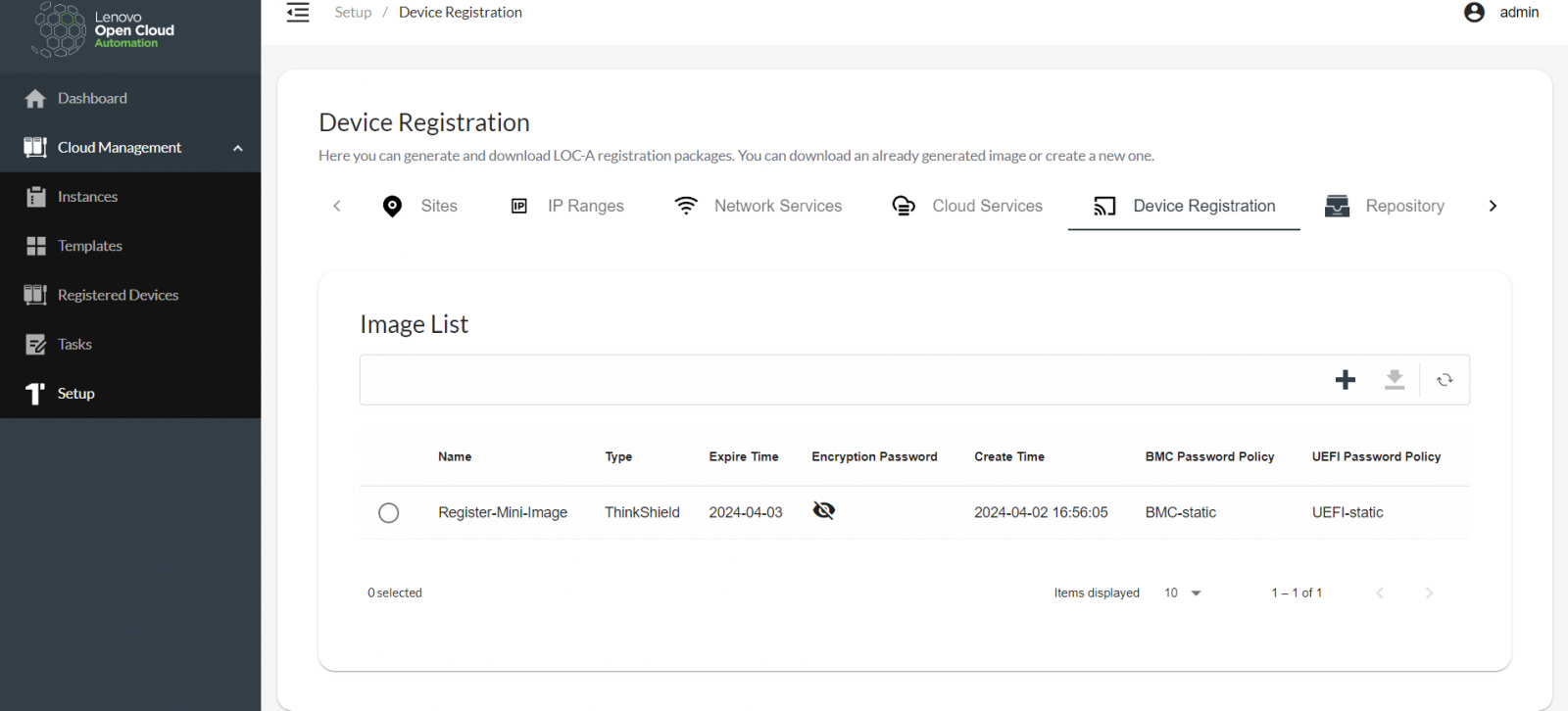
Figure 14. Generated Registration Image in the Lenovo Open Cloud Automation portal
Device on-boarding using nZTP
For greenfield deployment scenarios, Lenovo Open Cloud Automation implements a near Zero Touch Provisioning mechanism. The Field Technician, after setting up the devices on the location (racking, cabling, etc.), uses the Lenovo provided Registration Utility application which they have installed on their laptop and go through the process of connecting to each ThinkEdge server’s BMC.
In the Registration utility, the Field Technician loads the Registration image and selects the Site location for the server that they are onboarding. This activity needs to be performed for all servers to be registered. In the figure below you can see the result of the server registration process:
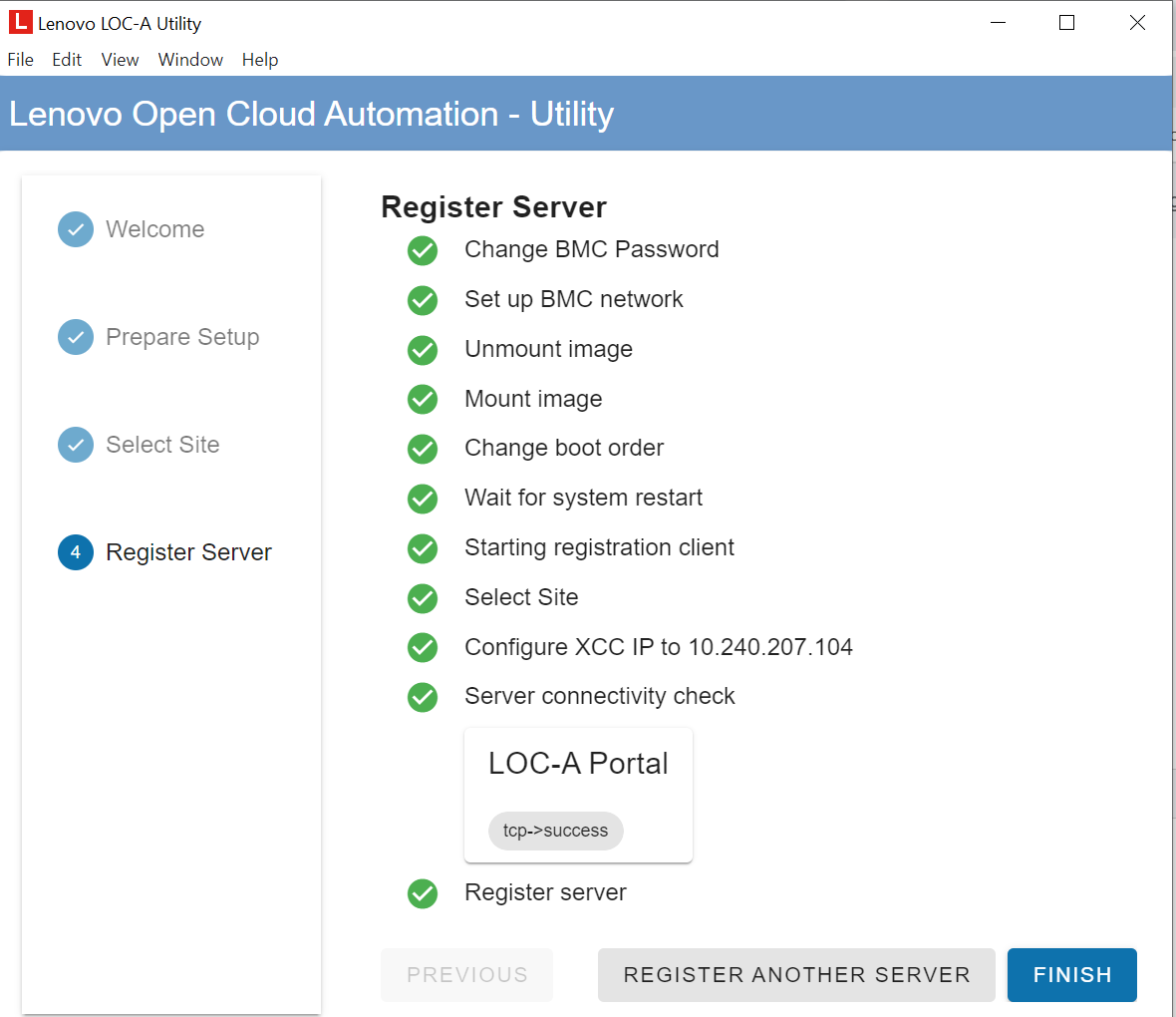
Figure 15. Registration Utility – successful server registration
Device on-boarding using XCC IP
For brownfield scenarios where the BMC networking and credentials have already been configured, the field technician can use the same Lenovo provided Registration Utility to onboard the respective devices, following a similar process while using the prior knowledge of the IP and credentials of the pre-configured BMC.
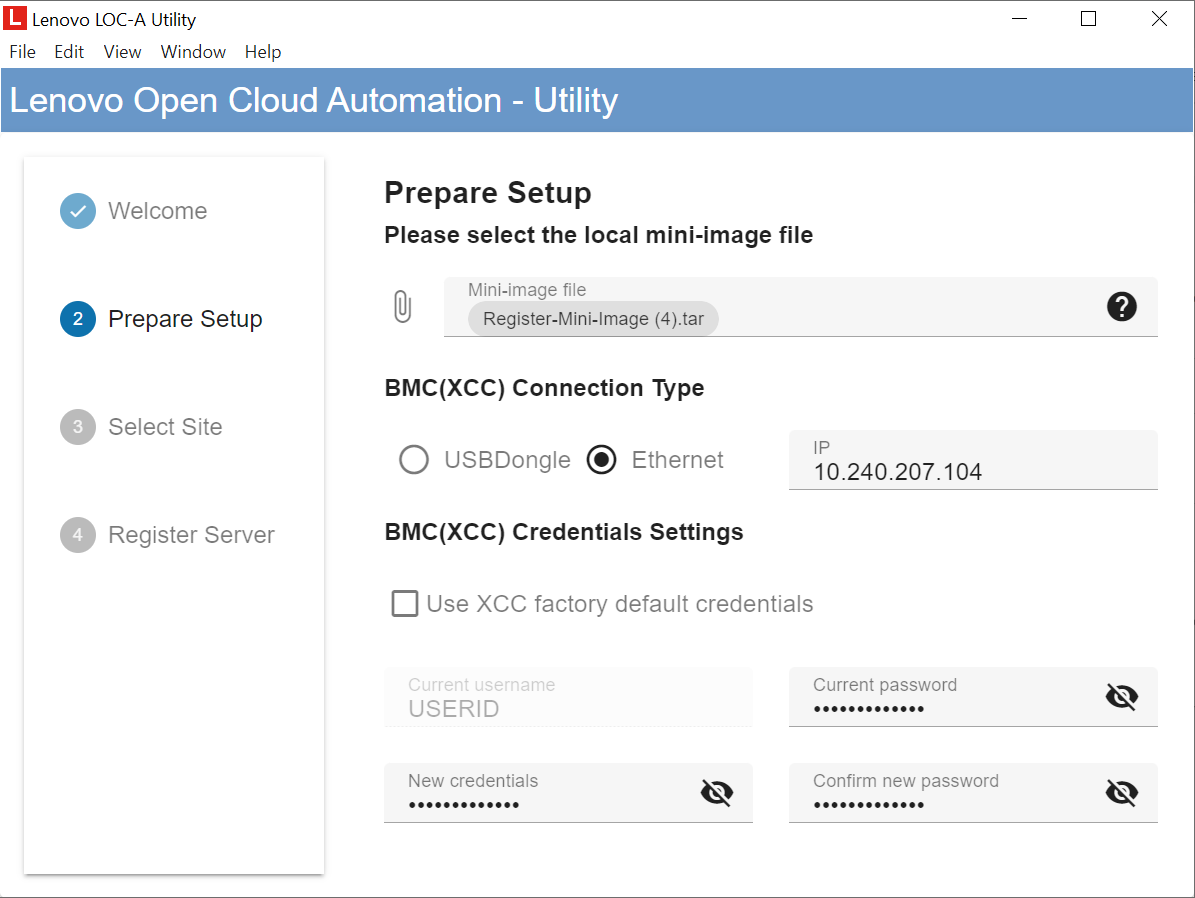
Figure 16. Registration Utility configuration for IP-based device on-boarding
Device on-boarding using XLSX file
When brownfield deployments involve large number of nodes, Lenovo Open Cloud Automation also offers the possibility of on-boarding servers in bulk using an excel file that the cloud admin uploads by navigating to the Registered Devices page. Below you can see an example of how that looks. This approach works for any kind of environment: data center, staging and edge.
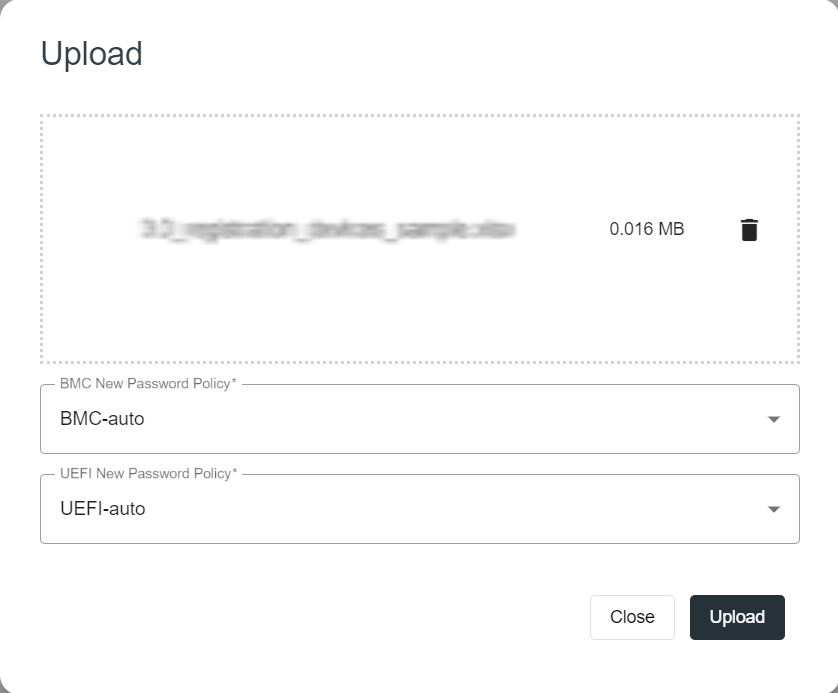
Figure 17. Bulk upload for IP-based server on-boarding
Device on-boarding using SLP-based discovery
For scenarios where LOC-A has access to the Layer 2 BMC network, to ease the bulk server registration, Lenovo Open Cloud Automation offers the possibility that the Infrastructure Admin Team can discover servers using SLP (Service Location Protocol) and do the on-boarding with a few clicks, for further provisioning.
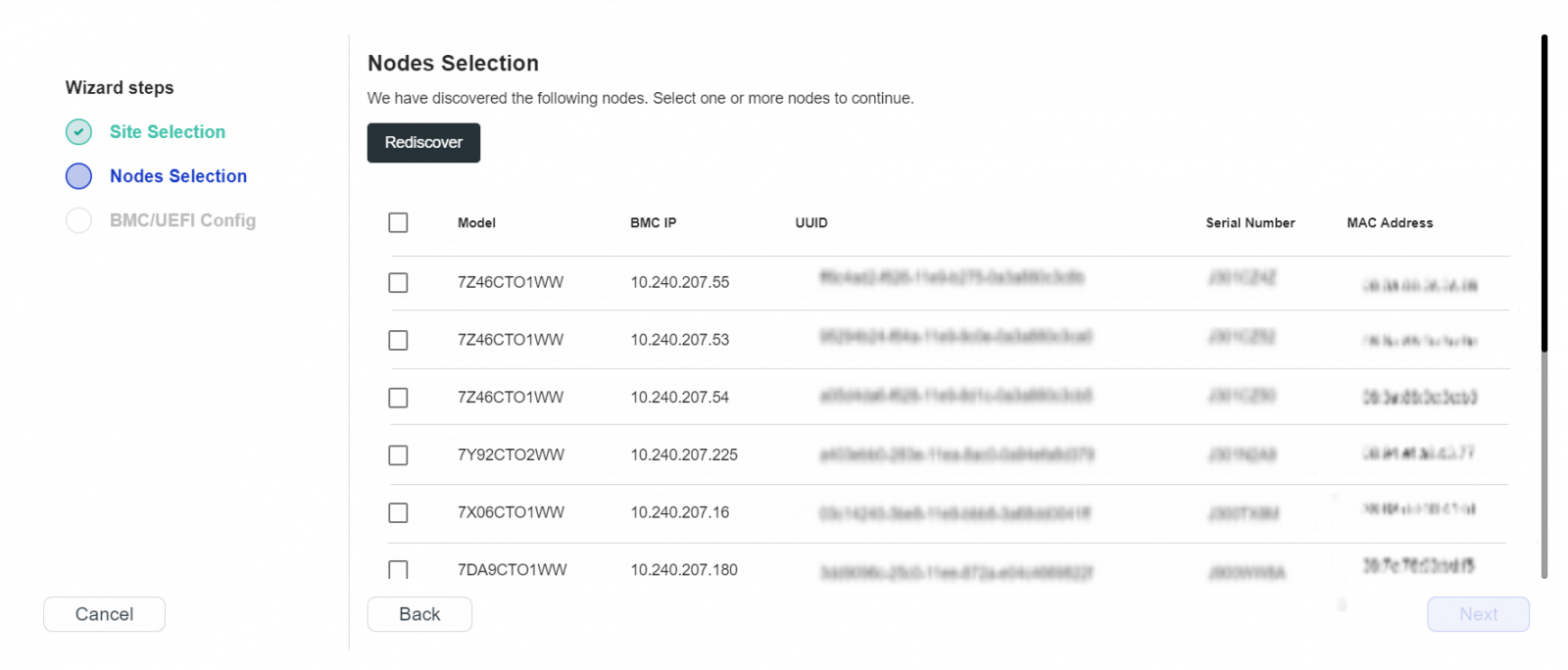
Figure 18. Server discovery from Lenovo Open Cloud Automation portal
Device on-boarding using Layer 3 discovery
When the devices’ BMC IP addresses and network configuration is done with DHCP or manually set beforehand (i.e.: in a brownfield deployment), the Infrastructure Admin Team can use Layer 3 discovery to quickly on-board the nodes into Lenovo Open Cloud Automation. This discovery method works in any environment: datacenter, staging area or edge, if the LOC-A Portal has access to the IP ranges allocated to the BMCs and the IP ranges are defined in the LOC-A Portal. Once discovered. The process in the Portal is similar to the server discovery via SLP protocol, with the advantage that it can be done across routed networks. This gives flexibility on where LOC-A Portal can be hosted.
The user-flow is similar to the L2 discovery for the regular users. For the LOC_A Admin, there is a minor change in the IP range configuration, where they need to choose if the IPs need to be allocated by LOC-A or they are set by someone else (manually or via DHCP).
Cluster and OS instance lifecycle management (creation, expansion, deletion)
The next step after the servers have been on-boarded is to create a cluster or an OS deploy instance. This step requires that the correct metadata has been populated for that cluster, that a cluster deployment template has been created and that the minimum number of servers needed for 1 instance have been on-boarded into Lenovo Open Cloud Automation. The cluster instance is created by navigating to the Instances page and by clicking the “+” button in the top right corner of the page.
The Infrastructure Admin Team selects the template that they want to instantiate, in what sites they want to instantiate it (they can select all the sites that are considered “Ready for deployment” and meet the conditions mentioned above) and then hits deploy.
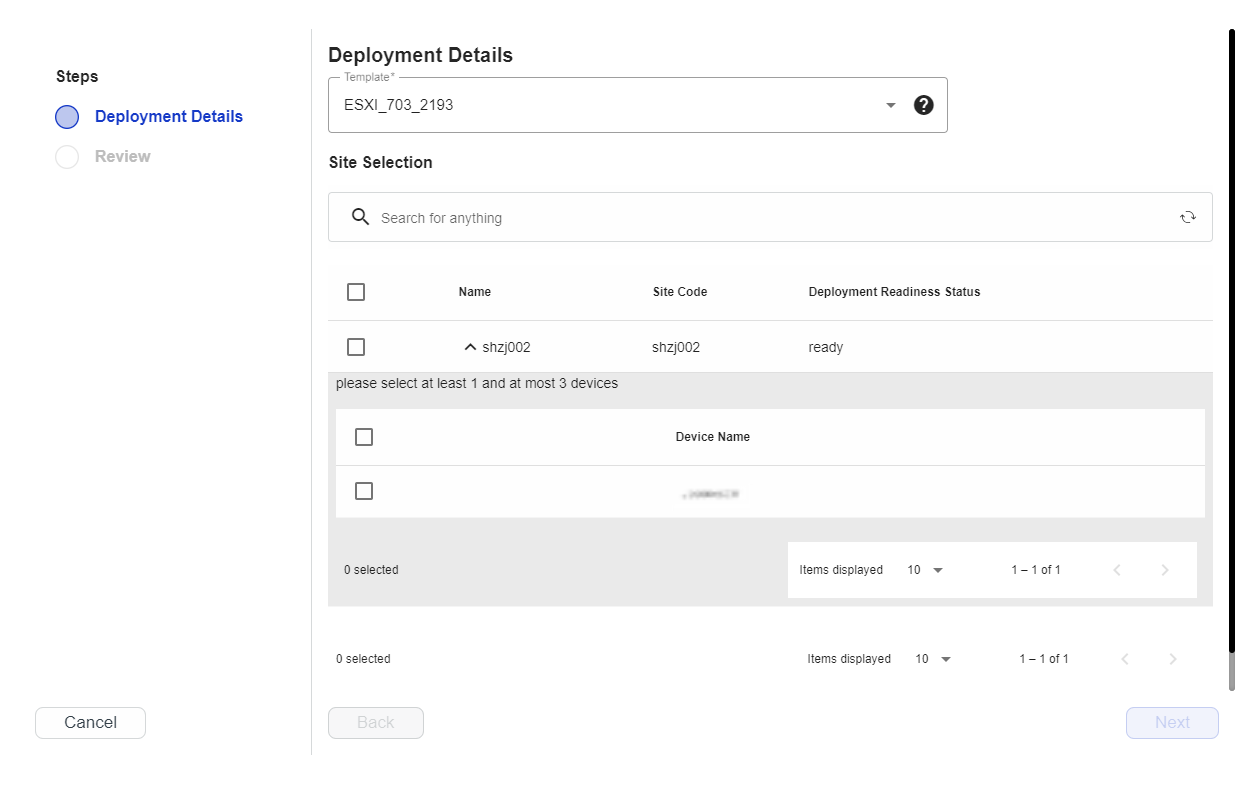
Figure 19. Instance creation, first step – template, site, and device selection
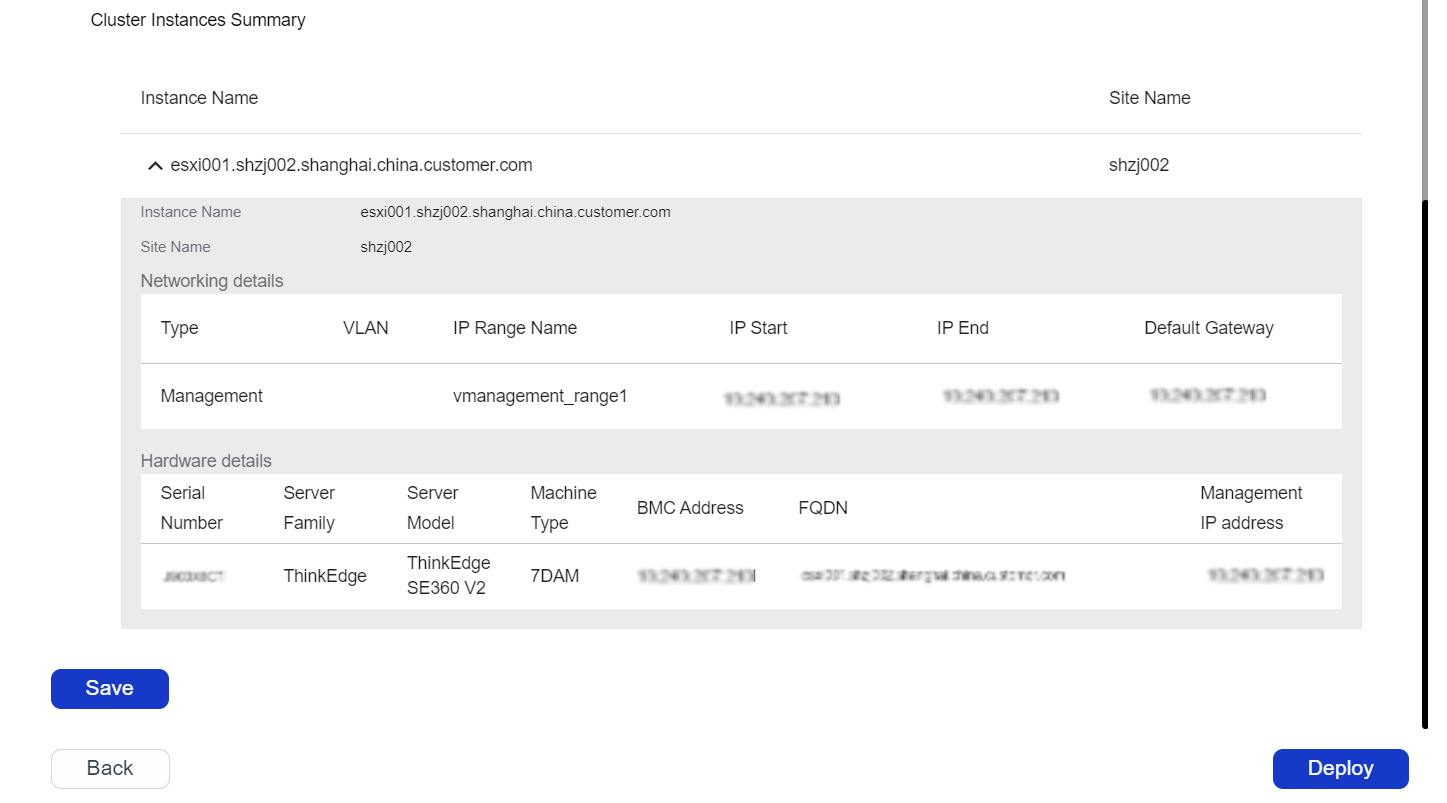
Figure 20. Instance creation, 2nd step – Metadata population, IP address assignment and device selection details
Automatic instance creation
For customers that are looking for more automation, “Automatic Instance Creation” is a feature that removes the need for the Infrastructure Admin to manually trigger the instance creation. This capability that can be enabled per “Deployment” in the LOC-A Portal. When enabled, it triggers instance creation immediately after all the pre-requisites are met.
Coupled with device discovery (either via L2 or L3) it is a very powerful feature that takes some of the burden off the Infrastructure Team.
Integration
Lenovo Open Cloud Automation uses a plugin-based architecture to enable new flavors to be easily added to the solution and offers a northbound API that supports various levels of integration with 3rd-party platforms, depending on the scenario.
Plugin architecture
Lenovo Open Cloud Automation (LOC-A) features a plugin mechanism that allows Lenovo partners to easily create and integrate their own automated flavors. The plugin leverages LOC-A’s advanced features, enabling key functions for partner platforms, including:
- Bare-metal server provisioning and onboarding
- Orchestration of server deployments
- Cluster and node instance creation (including OS deployment)
- Access to a smart naming convention engine for hostname, FQDN, etc.
This way, Lenovo partners can simplify their stack, leveraging already built automation that embeds years of experience and best practices.
Northbound API
Customers can use LOC-A as their IT infrastructure automation engine while exposing to their end-users a self-service portal for distributed resources consumption. This is done by using the northbound API exposed by LOC-A which allows for deeper integration, beyond that of the plugin mechanism. For more details, please get in touch with your Lenovo contact.
Partner integrations
The following offerings showcase how LOC-A's integration mechanisms can be leveraged to build full-stack solutions. Both the northbound API and the Plugin Mechanism help our partners use the unique LOC-A capabilities for faster time to market and optimized user experience.
- Lenovo ThinkAgile MX455 V3 Edge Premier Solution
Lenovo ThinkAgile MX455 V3 Edge Premier Solution, a turnkey AMD-based offering is part of the Microsoft Azure Stack HCI Premier solution category. It provides customers with an improved operational experience, accelerated time to value, and increased flexibility through as-a-service procurement options.
The ThinkAgile MX455 V3 Edge Premier Solution integrates Lenovo Open Cloud Automation (LOC-A) with Azure Stack HCI Cloud Deployment to facilitate near Zero Touch Provisioning. These services provide the elasticity needed to deploy a high number of servers in minimal time without overburdening existing IT departments. This offers the quickest and most convenient path to implementing a hyper-converged solution powered by Azure Stack HCI OS, featuring Hyper-V virtualization, Microsoft Storage Spaces Direct (S2D) for Software Defined Storage (SDS), and Software Defined Networking (SDN) for network virtualization.
This integration leverages the LOC-A plugin architecture to enable fast integration and help reduce the time to market for the integrated solution.
Starting with release 3.4, the ThinkAgile MX455 V3 Premier Edge nodes work with the Zero Touch Provisioning feature, by L2 and L3 network discovery. Also starting with 3.4, users can choose the version of the bootstrap depending on the device type: ThinkAgile MX455 V3 Edge Premier supports Azure Local version 2408.
- Lenovo ThinkAgile MX650 V3 2U Premier Solution
The ThinkAgile MX650 V3 Premier Solution includes the Azure Local version 23H2 operating system and Lenovo ThinkAgile support with single point of contact support for hardware and L1, L2 support for software from Lenovo. Customers can deploy and update features via Azure Arc and Windows Admin Center. The tight integration with Lenovo XClarity makes cluster management, hardware and software update management, and enforcement of site-wide policies easy for IT administrators. Using SBE PR (Solution Builder Extension for Premier Solution), the best recipes can be acquired via a one-click update. Native integration with Azure services makes it easy for customers to adopt a hybrid cloud strategy for their workloads.
Starting with release 3.4, the ThinkAgile MX650v3 Premier nodes work with the Zero Touch Provisioning feature, by L2 and L3 network discovery. Also starting with 3.4, users can choose the version of the bootstrap depending on the device type: ThinkAgile MX650 V3 Premier supports Azure Local version 2411.
- Intel Tiber Edge Platform
Intel Tiber Edge Platform is an end-to-end software platform that enables the building, deployment, running, securing, and management of scalable edge and AI solutions. LOC-A integrates with Tiber to enable the secure onboarding and management for fleets of edge nodes more efficiently and with lower TCO. It also deploys in an automated way the base OS provided by the Tiber platform. The integration highlighted above is yet another example of how the LOC-A plugin architecture is used to facilitate the collaboration between development teams from different organizations.
Benefits to users
Benefits to users include the following:
- Designed around an automated process that works with Lenovo servers regardless of where they are deployed: in a data center, in a staging environment or even at the Edge.
- Offers a web-based portal to on-board and deploy Lenovo infrastructure.
- Standard and plugin-based deployment flavors for many common use cases and scenarios.
- Lenovo pre-defined deployment templates and device profiles to provide an intuitive starting point for the Infrastructure Admin Team.
- Centralized credential policies that give the Infrastructure Admin Team control over how the infrastructure is secured.
- Onboard and deploy IT infrastructure across multiple sites simultaneously, from a single, simple workflow.
- Operating System image side-loading during device on-boarding to avoid transferring images during deployment.
- Simplified server onboarding process for the field-technician
- Task progress monitoring and log download
Usage workflows
The following figure is the workflow illustrating the main actions that can be performed and by what persona when nZTP is used:

Figure 21. LOC-A user flow - greenfield deployment scenario – nZTP
For greenfield or brownfield scenarios where server discovery with SLP is used, the user workflow is illustrated below:
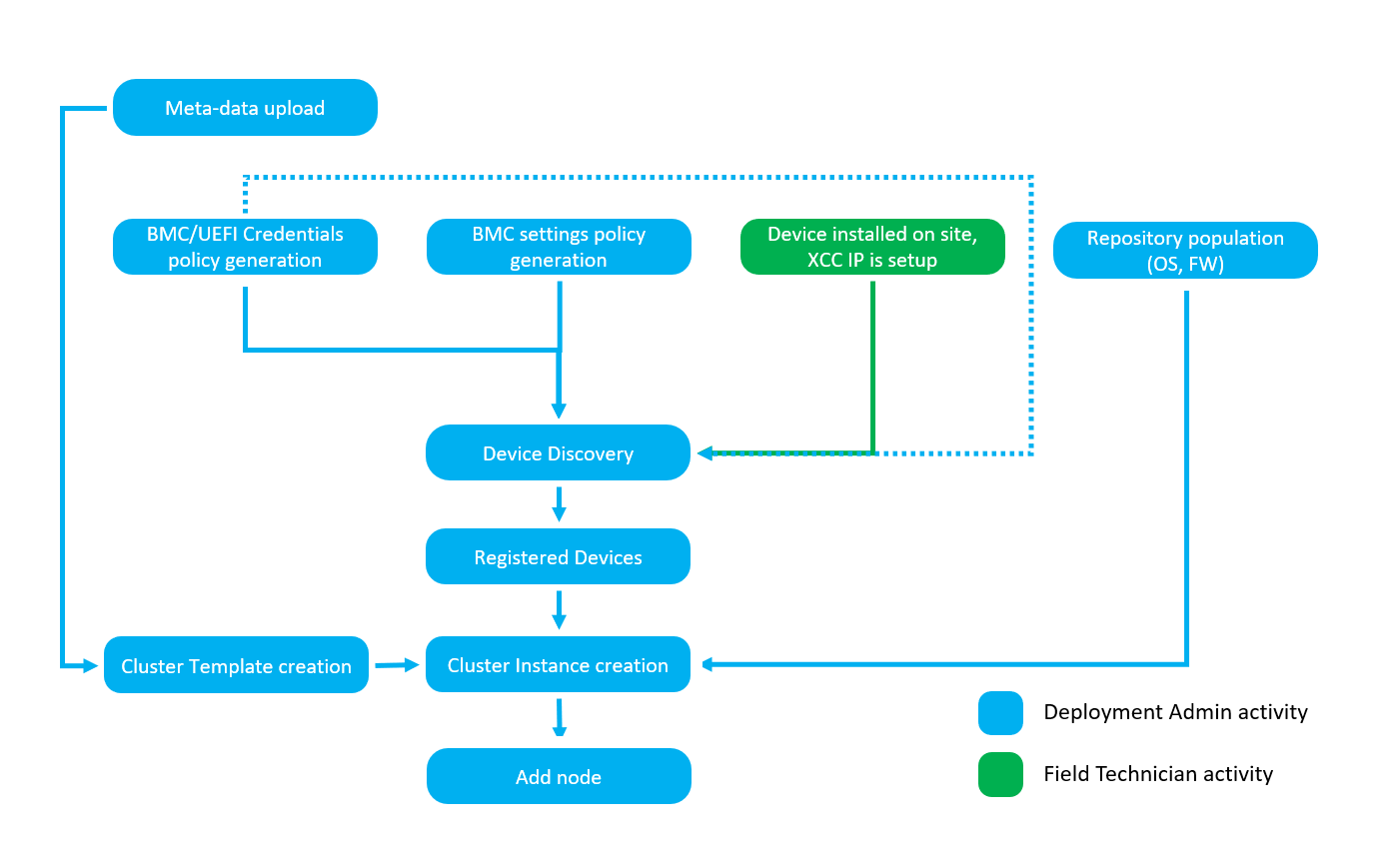
Figure 22. LOC-A user flow – Data center, staging and Edge deployment scenario – SLP & L3 discovery
In case of brownfield scenarios, but with field technician doing site surveys and on-boarding of devices with the Registration Utility, the user workflow is shown below.

Figure 23. LOC-A user flow - Data center, Staging and Edge brownfield deployment scenario – IP based on-boarding
For brownfield scenarios where the devices are already in the field and the Infrastructure Admin Team has an accurate inventory of the devices that contains information such as Serial Number, BMC IP address, Location, etc for each server, the user flow looks like in the below diagram.
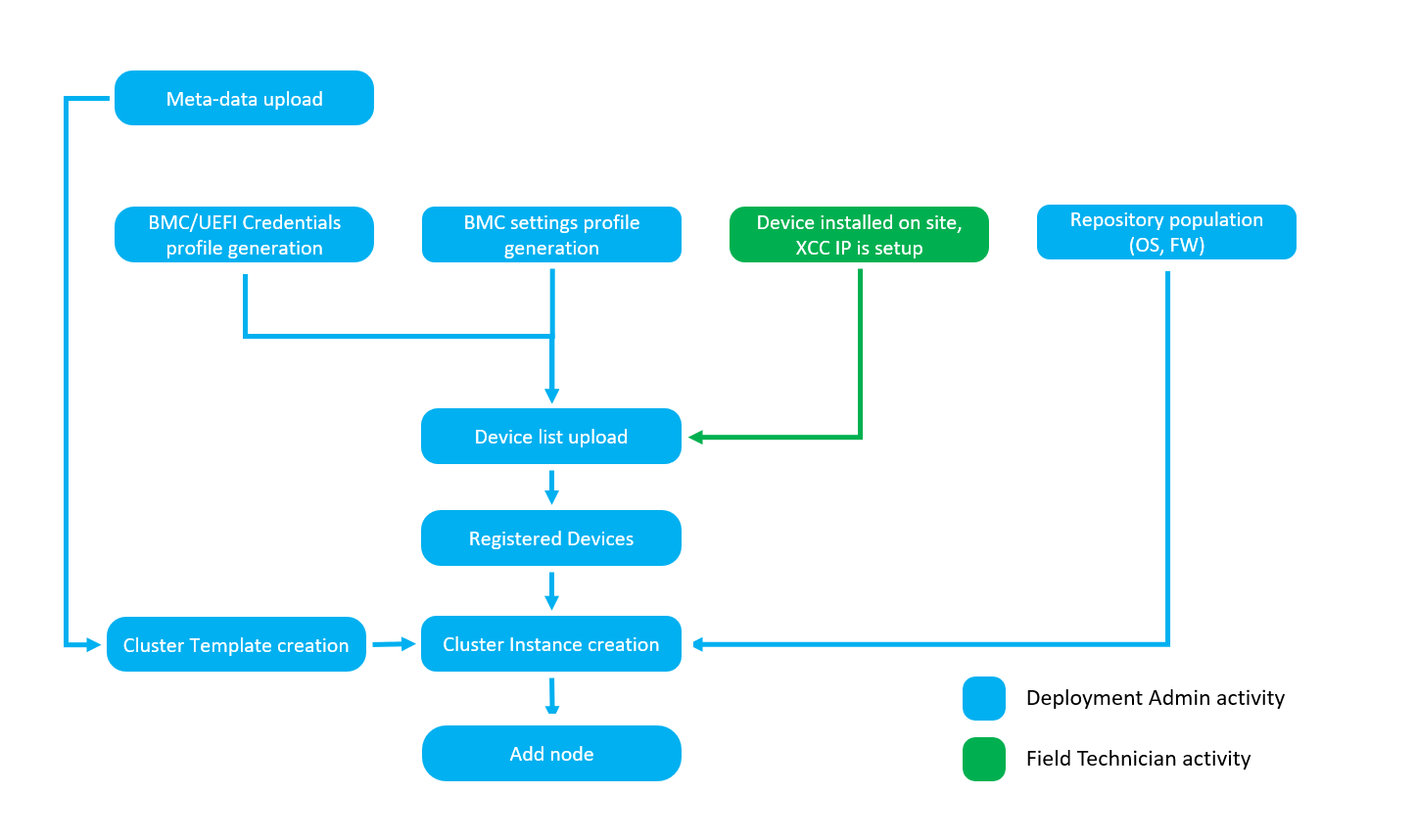
Figure 24. LOC-A user flow – Data center, Staging and Edge brownfield deployment scenarios – Inventory file based on-boarding
Features for LOC-A administrators
For LOC-A administrators the Setup page contains a few tabs that enable the administrators to perform tasks relevant for the day-to-day maintenance of the platform.
- Vault Configuration – In the Vaults tab, from the Setup page, Administrators can add, edit or delete their organization’s vaults. A secrets’ vault is used by LOC-A to both read already defined credentials for existing cloud services, and to store the credentials for OS, BMC or UEFI which LOC-A automatically generates when the credentials policy is set to *-auto.
- User Administration – Local User Management – provides the option to create, edit, search for, and delete local users.
- User Administration - LDAP configuration – Administrators can enable and configure their LDAP server parameters as well as the priority policy for Local vs. LDAP defined users.
- Tasks Management - The Tasks page displays a list of tasks executed by the users and their status. When clicking on an individual task the user can see details about the task such as the start- and end-time, the detailed error cause if the task is failed, the sub-tasks performed and their execution time. From the same modal that displays the details for a particular task, the user can download the logs specific for that task which helps narrow the investigation scope in case troubleshooting is needed. If logs for all tasks are needed, the user can download them from the main Tasks page where all the tasks are listed.
- License management – When first installed, LOC-A comes pre-loaded with a 90-day trial license activated which allows customers to test the features and decide if they want to continue using the product on a regular paid-for license. Once they decide to go for the commercial license, during the ordering process the customer receives from Lenovo feature activation codes that allow to enable additional functionality, as per the customer order.
- Maintenance mode – LOC-A can now be upgraded in-situ, without having to re-deploy the appliance. To ensure that users do not interfere with the process of migrating from one version to another, the administrator can now activate and deactivate maintenance mode from within the portal UI. No activities or tasks must be running for maintenance mode to be successfully enabled.
- Backup and restore - LOC-A backup and restore feature gives administrators the capability to back up their data and restore it in another LOC-A instance or store it in a safe location for disaster recovery purposes. The backup generation and restore activities are performed by the administrator and require maintenance mode to be activated.
- In-place version upgrade - For customers that want to keep up with the latest LOC-A versions and benefit from the improvements, and new features introduced, the upgrade process is streamlined and automated. The administrator obtains a version upgrade patch from Lenovo, uploads it in the LOC-A portal, activates maintenance mode and starts the upgrade process. The portal does the rest.
Installation
Lenovo Open Cloud Automation comes as an OVA appliance that can be easily on-boarded using the customer’s vCenter. Other Delivery options include a QCOW2 appliance There is no feature-function distinction between the 2 delivery methods and the customer can choose based on their existing infrastructure. For ThinkAgile MX455 V3 Premier, due to the specialized automaton that was implemented, we now offer a VHDX appliance that is also distinct in terms of features and functions as compared with the OVA and QCOW2 appliances. In terms of scalability, underneath the covers, the three appliances make use of Kubernetes, and the appliances can be scaled both vertically (increased number of allocated resources) but also horizontally (by creating more appliances that are used as worker nodes by the embedded Kubernetes cluster).
In terms of resources, the VMs where LOC-A is deployed need as a minimum, the following resources:
- 8 vCPUs
- 32 GB memory
- 300 GB disk
In terms of scalability, underneath the covers, LOC-A makes use of Kubernetes, and the appliances can be scaled both vertically (increased number of allocated resources) but also horizontally (by creating more appliances that are used as worker nodes by the embedded Kubernetes cluster).
More details can be found in the User Guide
Subscription and support
Lenovo Open Cloud Automation is enabled through a per-node subscription and support entitlement model, which once entitled for the nodes contained within the deployment, gives the customer access to LOC-A software updates and Lenovo support for the duration of the acquired term.
Lenovo will provide interoperability support for all software tools defined as validated with LOC-A, and development support (Level 3) for specific Lenovo-supported tools only. Open source and supported-vendor bugs/issues will be logged and tracked with their respective communities or companies if desired, with no guarantee from Lenovo for bug fixes. Full support details are provided at the support links below for each respective version of LOC-A. Additional support options may be available; please contact your Lenovo sales representative for more information.
- Lenovo provides support in English globally and in Chinese for China (24x7)
- Support response times are as follows:
- Severity 1 issues response is 1 business day.
- Other issues: 3 business days
LOC-A has 1-year lifecycle for each release, customer should upgrade to the latest version if out of support. New versions of LOC-A are released quarterly, usually in the last working day of the quarter.
The following table lists end of support for LOC-A versions.
Validated software components
The LOC-A Core Framework appliance provides a self-contained image, for quick installation, that contains all the services required to do the automated cloud deployment and management enrollment for servers. The services within the image run as services on top of a built-in K3S cluster.
Each LOC-A software release is validated against a defined configuration of software tools and Lenovo systems, to make deployment more straightforward and enable support. Other management tools, hardware systems and configurations outside the defined stack may be compatible with LOC-A, though not formally supported; to determine compatibility with other solutions, please check with your Lenovo sales representative.
The following software components are validated by Lenovo as part of the overall LOC-A software solution entitlement:
- Inventory Service (LIS) The Inventory service is the source-of-truth for the infrastructure that handles planning data and site-specific configuration, including site details, IP addresses and VLANs, cloud services, network services, and the cloud objects, such as tenants and clusters. The metadata for resources can be imported or created by users in the planning phase.
- Configuration Service (LCS) The Configuration service is an execution orchestrator built on AWX. LOC-A LCS is configured with predefined automation workflows and job templates that make managing the infrastructure easy and efficient.
- Hardware Management Service (LMS) The Hardware Management service helps to provision hardware and performs hardware management operations during the lifecycle of Lenovo servers. LOC-A includes Confluent and Lenovo OneCli as components of its Hardware Management Service. LMS is responsible for:
- Server inventory
- Server power operations (as required by the deployment process, not on-demand)
- Server operating system deployment
- Server firmware updates
- Server configuration
Technical Support for software means the provision of telephone or web-based technical assistance by Lenovo to the Customer’s technical contact(s) with respect to any software defects, errors, and product problems exhibited on supported Lenovo configurations.
Technical support does not cover help with the initial installation of the product, software how-to, training, and or configuring the production environment. Please contact your local Lenovo Sales Representative or Lenovo Business Partner for the best service offerings if you need assistance in these areas.
Supported ThinkEdge servers
LOC-A seamlessly integrates with Lenovo ThinkEdge servers, offering robust support for Lenovo hardware within the cluster.
The following Lenovo systems are supported to be deployed with LOC-A:
- ThinkEdge SE350 V2 – The SE350 V2 is a purpose-built server that is half the width and significantly shorter than a traditional server, making it ideal for deployment in tight spaces. It can be mounted on a wall, ceiling mount, placed on a shelf or mounted in a rack. The ThinkEdge SE350 V2 server puts increased processing power, storage, and network closer to where data is generated. For customers that want to install server outside data center looking for reduced latency by processing at the edge. For more information, see the SE350 V2 product guide.
- ThinkEdge SE360 V2 – The SE360 V2 is a purpose-built server that is a 2U high and half width making it significantly smaller than a traditional server, ideal for deployment in tight spaces. It can be mounted on a wall, ceiling, placed on a desk or mounted in a rack. The ThinkEdge SE360 V2 server puts increased processing power, storage and network closer to where data is generated. For customers that want on-premise deployments and outside data center looking for reduced latency by processing at the edge. For more information, see the SE360 V2 product guide.
- ThinkEdge SE450 – The ThinkEdge SE450 is a single-socket server with a 2U height and short depth case, making it suitable for deployment in shallow cabinets. It is based on the 3rd Gen Intel Xeon Scalable processor. The SE450 can be mounted on a wall, stacked on a shelf or mounted in a rack. The server puts increased processing power, storage and network closer to where data is generated, allowing actions resulting from the analysis of that data to take place more quickly. For more information, see the SE450 product guide.
- ThinkEdge SE455 V3 - The ThinkEdge SE455 V3 is a single-socket server with a 2U height and short depth case, making it suitable for deployment in shallow cabinets. It can be mounted in a 2-post or 4-post rack. The SE455 V3 uses the new AMD EPYC 8004 Series "Siena" processors for an ideal mix of performance and power efficiency. The SE455 V3 puts processing power, storage and network closer to where data is generated, allowing actions resulting from the analysis of that data to take place more quickly. For more information, see the SE455 V3 product guide
- ThinkAgile MX455 V3 Edge Premier Solution - The Lenovo ThinkAgile MX455 V3 Edge Premier Solution is designed for deploying highly available, hyper-converged infrastructure (HCI) from Microsoft on purpose-built Lenovo edge servers in the remote offices/branch offices (ROBO) and at the edge. The ThinkAgile MX455 V3 Edge Premier Solution delivers fully validated and integrated Lenovo hardware and firmware that is certified for Microsoft Azure Stack HCI solutions. For more information, see the ThinkAgile MX455 V3 Edge Premier Solution product guide
Additional Lenovo ThinkSystem servers may be compatible with LOC-A. Contact your Lenovo sales representative for more information.
Supported ThinkSystem servers
- ThinkAgile MX650 V3 Premier Solution - The Lenovo ThinkAgile MX650 V3 Premier Solution is a 2-socket 2U system that is designed for deploying highly available, highly scalable hyper-converged infrastructure (HCI) and software-defined storage (SDS) from Microsoft on Lenovo enterprise platforms that feature 5th Generation Intel Xeon Scalable processors (formerly codenamed "Emerald Rapids) and 4th Generation Intel Xeon Scalable processors (formerly codenamed "Sapphire Rapids). The MX650 V3 Premier Solution delivers fully validated and integrated Lenovo hardware and firmware that is certified for Microsoft Azure Local solutions. For more information, see the ThinkAgile MX650 V3 Premier Solution Product Guide.
- ThinkSystem SR650 V3 & SR650 V2 Servers - The Lenovo ThinkSystem SR650 V3 & SR650 V2 are ideal 2-socket 2U rack serversfor small businesses up to large enterprises that need industry-leading reliability, management, and security, as well as maximizing performance and flexibility for future growth. The SR650 V3 & SR650 V2 are designed to handle a wide range of workloads, such as databases, virtualization and cloud computing, virtual desktop infrastructure (VDI), infrastructure security, systems management, enterprise applications, collaboration/email, streaming media, web, and HPC. For more information, see the ThinkSystem SR650 V3 Server Product Guide and ThinkSystem SR650 V2 Server Product Guide
- ThinkSystem SR630 V3 & SR630 V2 Servers - The Lenovo ThinkSystem SR630 V3 & SR630 V2 are an ideal 2-socket 1U rack servers for small businesses up to large enterprises that need industry-leading reliability, management, and security, as well as maximizing performance and flexibility for future growth. The SR630 V3 & SR630 V2 are designed to handle a wide range of workloads, such as databases, virtualization and cloud computing, virtual desktop infrastructure (VDI), infrastructure security, systems management, enterprise applications, collaboration/email, streaming media, web, and HPC. For more information, see the ThinkSystem SR630 V3 Server Product Guide and ThinkSystem SR630 V2 Server Product Guide
Additional Lenovo ThinkSystem servers may be compatible with LOC-A. Contact your Lenovo sales representative for more information.
Client PC requirements
A web browser is used to access the LOC-A portal. To fully utilize LOC-A’s capabilities, the client PC should meet the following specifications:
- Hardware: CPU of 2.0 GHz or above and 4 GB or more of RAM
- Display resolution: 1280 x 800 or higher
- Browser: Chrome (v62.0 or higher) or Firefox (v56.0 or higher) is recommended
A Microsoft Windows® based laptop or tablet is required to be used by the field technician when running the Lenovo Open Cloud Automation Registration Utility. Since the utility is delivered as a fully stand-alone, self-contained application, it does not have any dependencies on the Operating System and the requirements on the laptop specifications are as follows:
- Hardware: CPU of 1.8 GHz or above and 2 GB or more of RAM; RJ45 port or USB to Ethernet adapter for connecting with an Ethernet cable to the server XCC RJ45 port.
- Display resolution: 640 x 480 or higher
- Browser: N/A – the utility does not run in a browser, it’s a native application
Seller Training Courses
The following sales training courses are offered for employees and partners (login required). Courses are listed in date order.
-
Lenovo Open Cloud Automation Education
2023-03-24 | 25 minutes | Employees and Partners
DetailsLenovo Open Cloud Automation Education
In this course we will cover an overview of what is Lenovo Open Cloud Automation. By the end of this course, you will be able to describe the benefits of the Lenovo Open Cloud Automation, identify the user extensible technologies that LOC-A integrates, and explain why a customer should choose the Lenovo Open Cloud Automation. The course was last updated in March 2023.
Published: 2023-03-24
Tags: Cloud, DataCenter Products, Server, ThinkAgile, ThinkEdge, ThinkSystem, VMware
Length: 25 minutes
Course code: DLOCO101r2Start the training:
Employee link: Grow@Lenovo
Partner link: Lenovo 360 Learning Center
Related links
For more information, see the following resources:
- LOC-A web page:
https://www.lenovo.com/us/en/servers-storage/software/open-cloud-automation/ - LOC-A Support website:
https://support.lenovo.com/us/en/solutions/HT509884 - ThinkAgile MX455 V3 Edge Premier Solution for AI – solution brief
https://lenovopress.lenovo.com/lp1983-thinkagile-mx455-v3-edge-premier-solution-for-ai - Intel Tiber Edge Platform
https://www.intel.com/content/www/us/en/developer/topic-technology/edge-5g/edge-platform/overview.html - Lenovo DCSC configurator:
https://dcsc.lenovo.com
Trademarks
Lenovo and the Lenovo logo are trademarks or registered trademarks of Lenovo in the United States, other countries, or both. A current list of Lenovo trademarks is available on the Web at https://www.lenovo.com/us/en/legal/copytrade/.
The following terms are trademarks of Lenovo in the United States, other countries, or both:
Lenovo®
ThinkAgile®
ThinkEdge®
ThinkSystem®
XClarity®
The following terms are trademarks of other companies:
AMD and AMD EPYC™ are trademarks of Advanced Micro Devices, Inc.
Intel®, the Intel logo, Intel Tiber®, Tiber®, and Xeon® are trademarks of Intel Corporation or its subsidiaries.
Linux® is the trademark of Linus Torvalds in the U.S. and other countries.
Microsoft®, Arc®, Azure®, Excel®, Hyper-V®, and Windows® are trademarks of Microsoft Corporation in the United States, other countries, or both.
Other company, product, or service names may be trademarks or service marks of others.
Configure and Buy
Full Change History
Changes in the April 24, 2025 update:
- Updated for LOC-A 3.4 – see the What’s new in LOC-A 3.4 section
- New feature added: Meta-data editing directly in the portal – see the Deployment planning section
- New feature added: Server registration and provisioning in datacenter by discovery for ThinkAgile MX Premier - see the Partner integrations section
- New feature added: Add support for multiple bootstrap versions - see the Partner integrations section
- New feature added: Add support for Cloud-Init - Cluster Template creation section
- Feature update: New version supported for Ubuntu – 24.04 - Cluster Template creation section
- New HW platforms supported: ThinkSystem SR650 V2, SR650 V3, SR630 V2, SR630 V3 - Supported ThinkSystem servers section
- Feature update: Improved Northbound API – see Integration section
Changes in the February 16, 2025 update:
- Updated for LOC-A 3.3 - see the What’s new in LOC-A 3.3 section
- New feature added: Ability to add metadata without using the Excel template – see the Deployment planning section
- New concept introduced – see the Deployments section
- New feature added – see the Automatic instance creation section
- New feature added – see the Device on-boarding using Layer 3 discovery section
- New feature added – see the Partner Integrations section
- Overall update of verbiage to reflect that Lenovo Open Cloud Automation can be used in data center, staging and edge environments and that it now supports Lenovo ThinkSystem rack servers together with Lenovo ThinkEdge servers
Changes in the October 18, 2024 update:
- Updated for LOC-A 3.2 - see the What’s new in LOC-A 3.2 section
- Updated the part number tables in the Ordering information section
- New section Open for integrations
Changes in the July 23, 2024 update:
- Updated for LOC-A 3.1 - see the What’s new in LOC-A 3.1 section
First published: June 21, 2024
Course Detail
Employees Only Content
The content in this document with a is only visible to employees who are logged in. Logon using your Lenovo ITcode and password via Lenovo single-signon (SSO).
The author of the document has determined that this content is classified as Lenovo Internal and should not be normally be made available to people who are not employees or contractors. This includes partners, customers, and competitors. The reasons may vary and you should reach out to the authors of the document for clarification, if needed. Be cautious about sharing this content with others as it may contain sensitive information.
Any visitor to the Lenovo Press web site who is not logged on will not be able to see this employee-only content. This content is excluded from search engine indexes and will not appear in any search results.
For all users, including logged-in employees, this employee-only content does not appear in the PDF version of this document.
This functionality is cookie based. The web site will normally remember your login state between browser sessions, however, if you clear cookies at the end of a session or work in an Incognito/Private browser window, then you will need to log in each time.
If you have any questions about this feature of the Lenovo Press web, please email David Watts at dwatts@lenovo.com.

